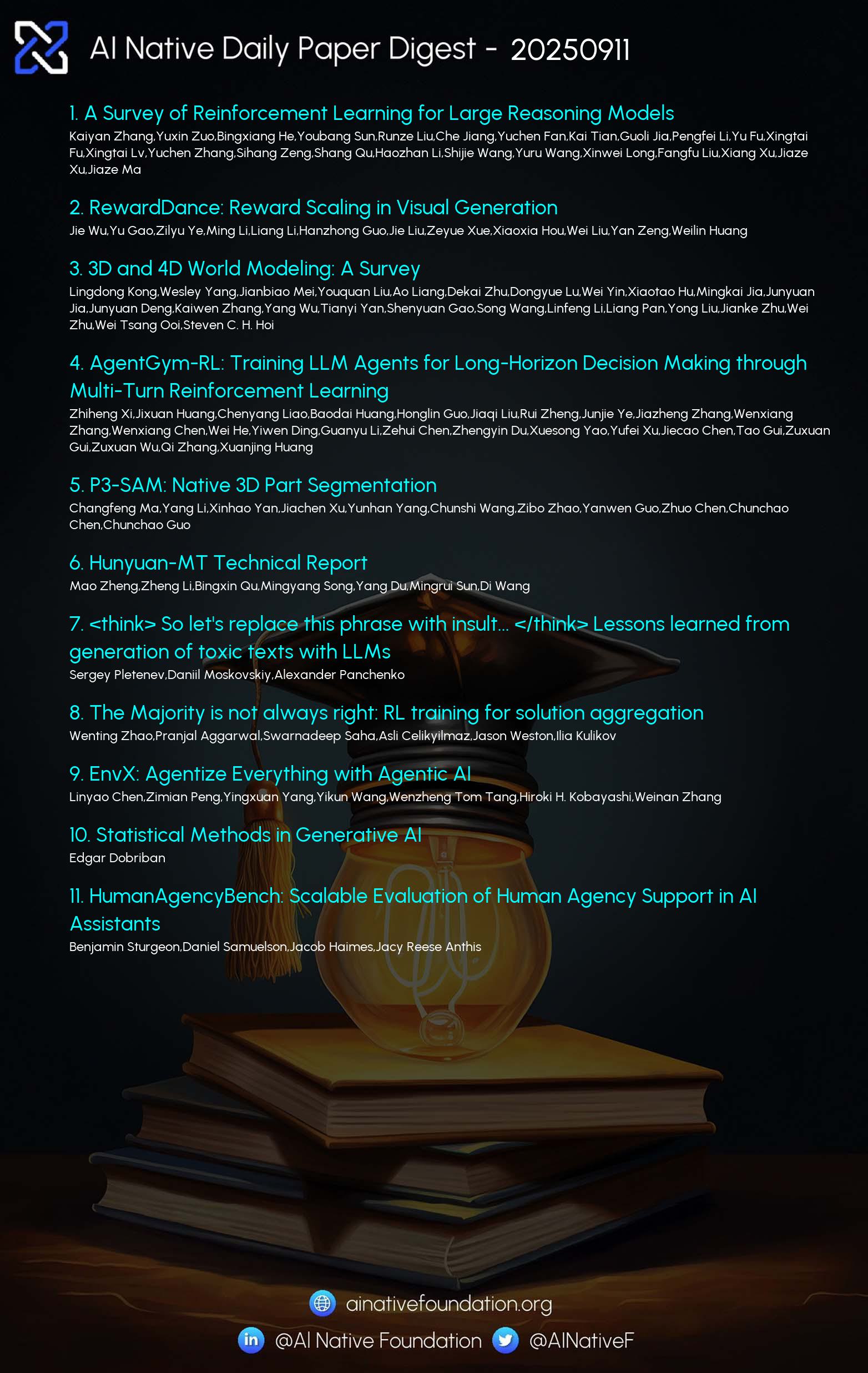AI Native Daily Paper Digest – 20250911

1. A Survey of Reinforcement Learning for Large Reasoning Models
🔑 Keywords: Reinforcement Learning, Large Language Models, Artificial SuperIntelligence, DeepSeek-R1, Reasoning Abilities
💡 Category: Reinforcement Learning
🌟 Research Objective:
– The paper surveys recent advancements in using Reinforcement Learning (RL) to enhance reasoning capabilities of Large Language Models (LLMs) for complex logical tasks.
🛠️ Research Methods:
– Examines the application of RL to LLMs and LRMs, addressing key areas such as algorithm design, training data, infrastructure, and identifies foundational components and core problems.
💬 Research Conclusions:
– The review aims to promote further research and develop strategies for scaling RL towards Artificial SuperIntelligence, providing insights into future opportunities and directions in the evolving domain.
👉 Paper link: https://huggingface.co/papers/2509.08827
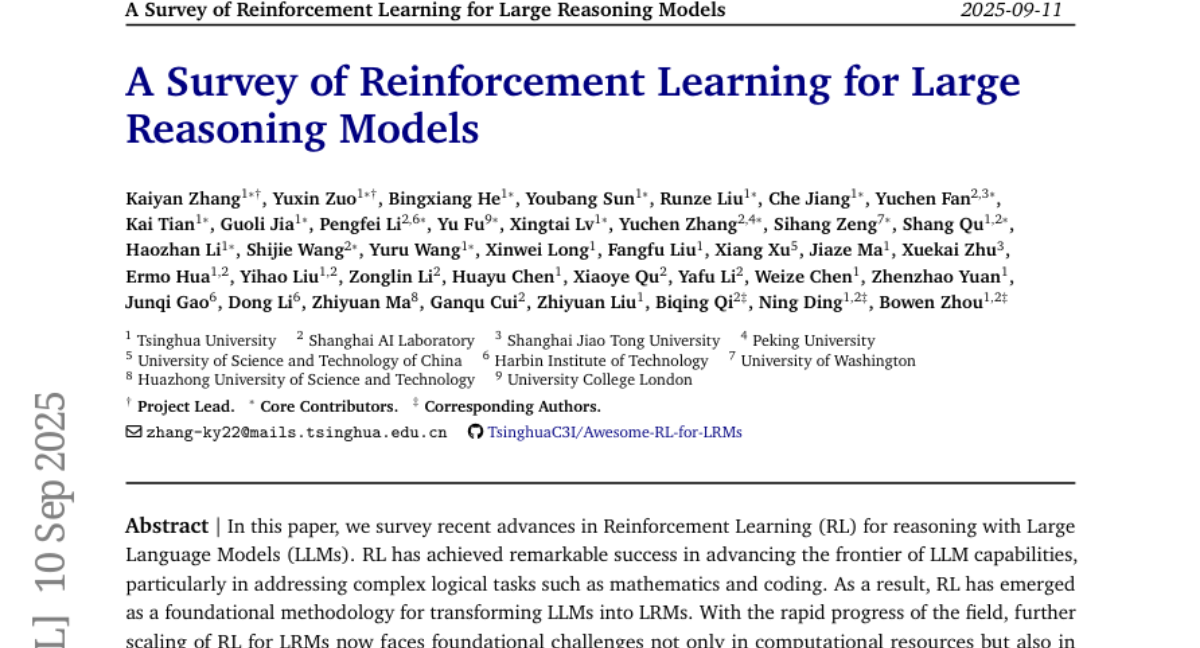
2. RewardDance: Reward Scaling in Visual Generation
🔑 Keywords: RewardDance, Reward Models, Generative Models, Reinforcement Learning, Visual Generation
💡 Category: Generative Models
🌟 Research Objective:
– The paper introduces RewardDance, a scalable reward modeling framework designed to align with Vision-Language Model (VLM) architectures to enhance reward model (RM) scaling and resolve reward hacking issues in AI generated content.
🛠️ Research Methods:
– RewardDance employs a novel generative reward paradigm that reforms the reward score as the probability of predicting a “yes” token, thereby aligning reward objectives with VLMs.
– It enables both model scaling up to 26 billion parameters and context scaling by integrating task-specific instructions and chain-of-thought reasoning.
💬 Research Conclusions:
– RewardDance surpasses state-of-the-art methods in text-to-image, text-to-video, and image-to-video generation.
– The framework successfully addresses reward hacking by maintaining high reward variance, thereby supporting diverse and high-quality output while alleviating mode collapse issues in smaller models.
👉 Paper link: https://huggingface.co/papers/2509.08826
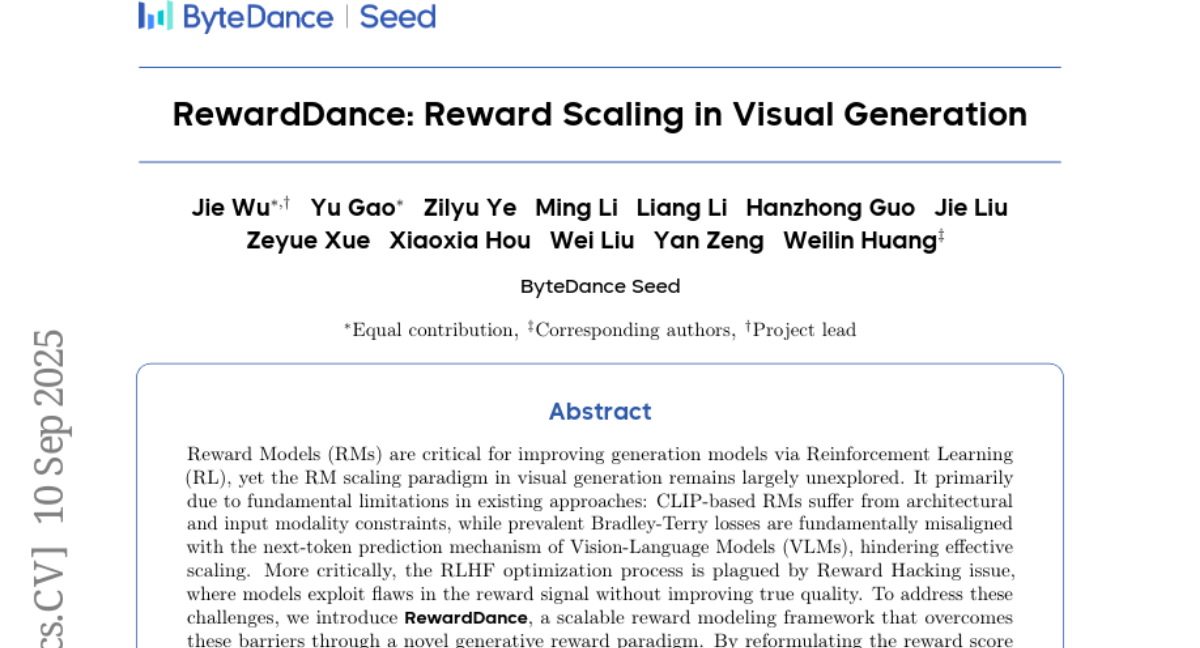
3. 3D and 4D World Modeling: A Survey
🔑 Keywords: 3D world modeling, 4D world modeling, AI Native, RGB-D imagery, LiDAR point clouds
💡 Category: Computer Vision
🌟 Research Objective:
– To provide a comprehensive review of 3D and 4D world modeling and generation, including definitions, taxonomy, datasets, applications, and evaluation metrics.
🛠️ Research Methods:
– Introduction of structured taxonomy for video-based, occupancy-based, and LiDAR-based approaches, along with a systematic summary of datasets and evaluation metrics specific to 3D/4D settings.
💬 Research Conclusions:
– The survey fills gaps in literature by offering a foundational reference for future research in 3D and 4D world modeling, identifying open challenges and promising research directions.
👉 Paper link: https://huggingface.co/papers/2509.07996
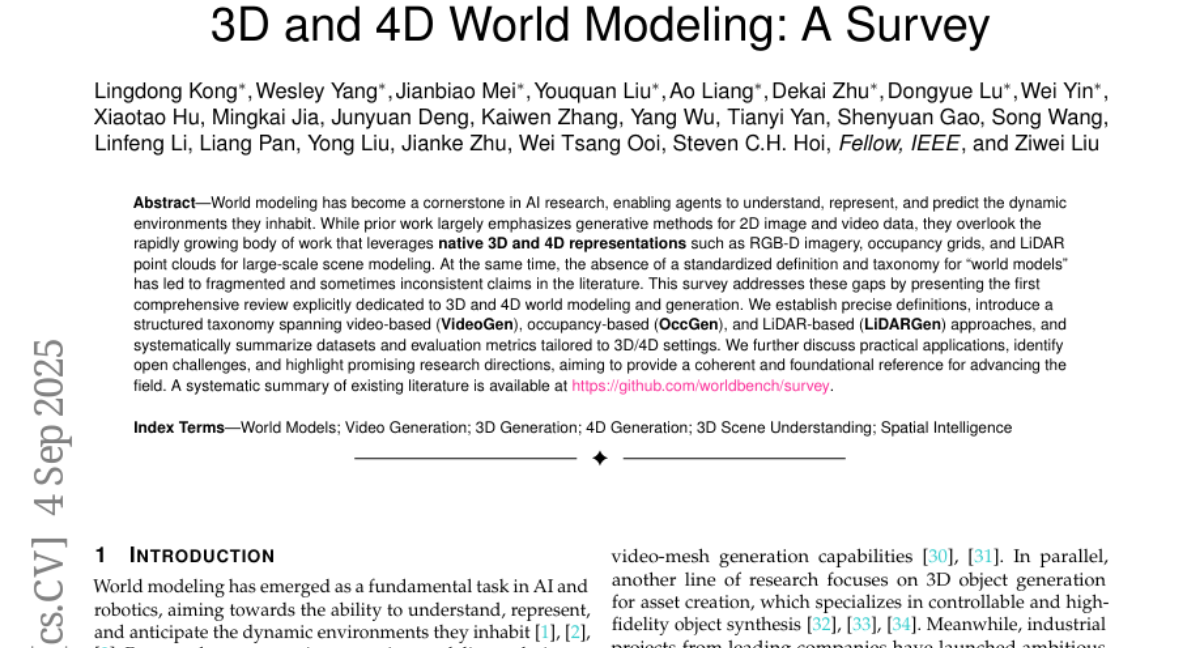
4. AgentGym-RL: Training LLM Agents for Long-Horizon Decision Making through Multi-Turn Reinforcement Learning
🔑 Keywords: AgentGym-RL, LLM agents, RL, ScalingInter-RL, decoupled architecture
💡 Category: Reinforcement Learning
🌟 Research Objective:
– The study aims to develop AgentGym-RL, a modular RL framework, designed to train LLM agents without supervised fine-tuning in various environments.
🛠️ Research Methods:
– Implements a modular and decoupled architecture supportive of mainstream RL algorithms, featuring a new approach called ScalingInter-RL for achieving exploration-exploitation balance.
💬 Research Conclusions:
– Agents trained using AgentGym-RL demonstrated stability and effectiveness, matching or surpassing commercial models on 27 tasks, with the framework and its components being open-sourced for the research community.
👉 Paper link: https://huggingface.co/papers/2509.08755
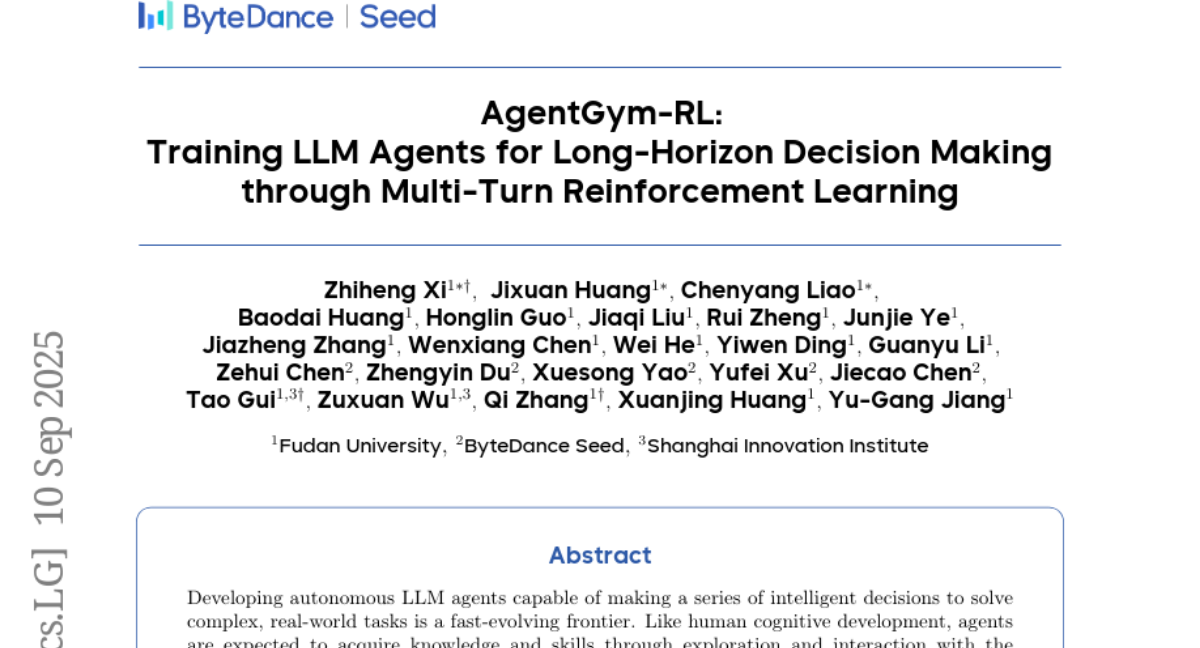
5. P3-SAM: Native 3D Part Segmentation
🔑 Keywords: P3-SAM, 3D point-promptable, segmentation, feature extractor, IoU predictor
💡 Category: Computer Vision
🌟 Research Objective:
– The paper introduces P3-SAM, designed to achieve full automation in segmenting any 3D objects into components.
🛠️ Research Methods:
– P3-SAM leverages a feature extractor, multiple segmentation heads, and an IoU predictor to perform precise and robust segmentation.
💬 Research Conclusions:
– P3-SAM demonstrates state-of-the-art performance with precise results and strong robustness, validated through a large dataset of nearly 3.7 million models.
👉 Paper link: https://huggingface.co/papers/2509.06784
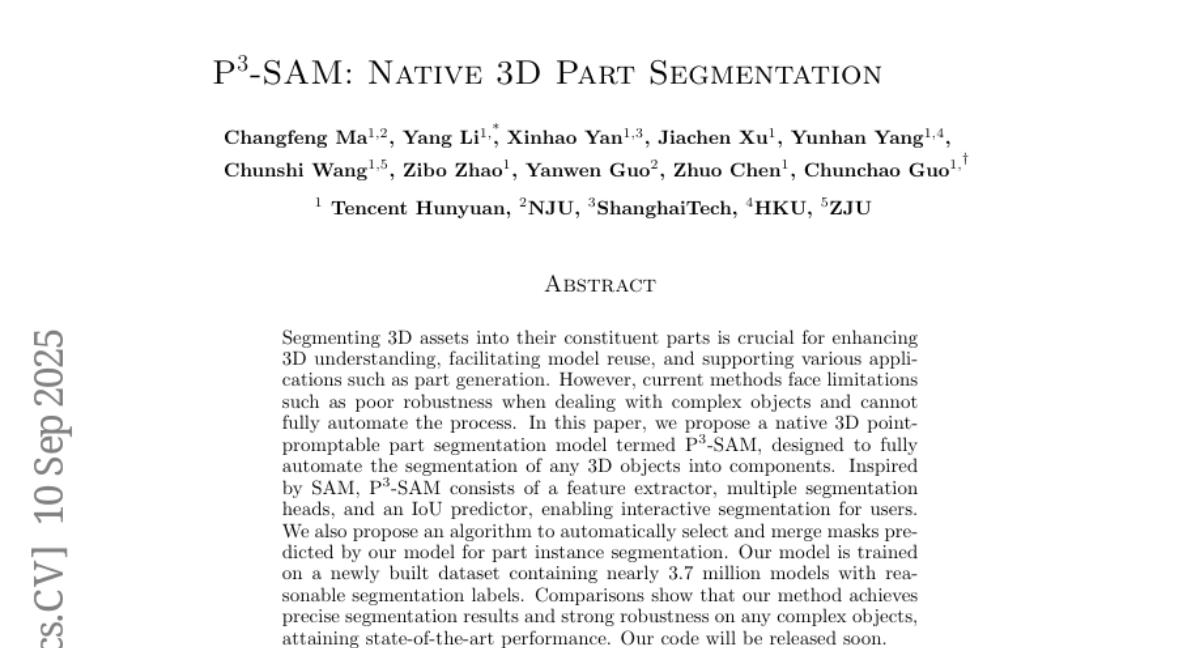
6. Hunyuan-MT Technical Report
🔑 Keywords: Hunyuan-MT-7B, Hunyuan-MT-Chimera-7B, multilingual translation, Reinforcement Learning, Chain-of-Thought (CoT)
💡 Category: Natural Language Processing
🌟 Research Objective:
– Introduce and exhibit the efficacy of Hunyuan-MT-7B and Hunyuan-MT-Chimera-7B models for multilingual translation, particularly between Mandarin and minority languages.
🛠️ Research Methods:
– Employed a comprehensive training framework involving pre-training, Supervised Fine-Tuning (SFT), and advanced alignment through Reinforcement Learning.
💬 Research Conclusions:
– Both models significantly outperform comparably sized translation models and most SOTA large models, achieving first place in 30 out of 31 language pairs in the WMT2025 shared task; they demonstrate robustness across a wide range of languages.
👉 Paper link: https://huggingface.co/papers/2509.05209
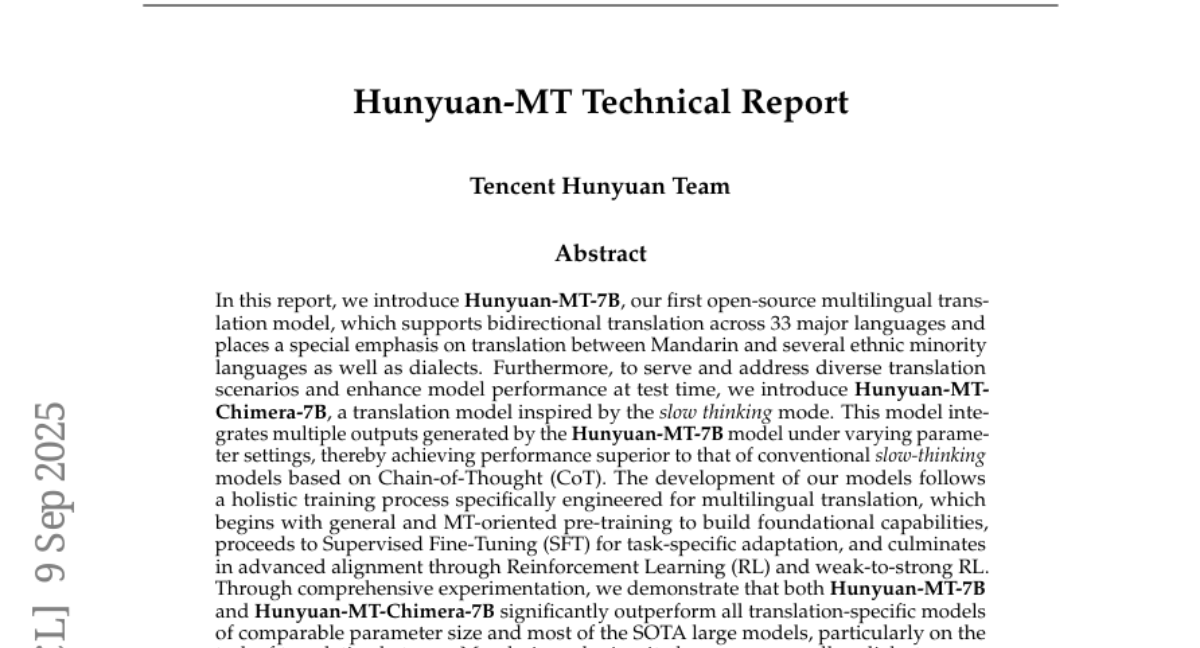
7. The Majority is not always right: RL training for solution aggregation
🔑 Keywords: Reinforcement Learning, Large Language Models, Aggregation, Reasoning Tasks, Verifiable Rewards
💡 Category: Reinforcement Learning
🌟 Research Objective:
– To improve the performance of large language models on reasoning tasks by developing a reinforcement learning-based aggregation method that synthesizes correct answers from multiple candidate solutions.
🛠️ Research Methods:
– Proposed a method to learn aggregation as an explicit reasoning skill using reinforcement learning from verifiable rewards, balancing easy and hard training examples to train an aggregator model.
💬 Research Conclusions:
– The proposed method, AggLM, outperforms rule-based and reward-model baselines across multiple benchmarks. It effectively generalizes to solutions from different models and requires fewer tokens than majority voting with larger solution sets.
👉 Paper link: https://huggingface.co/papers/2509.06870
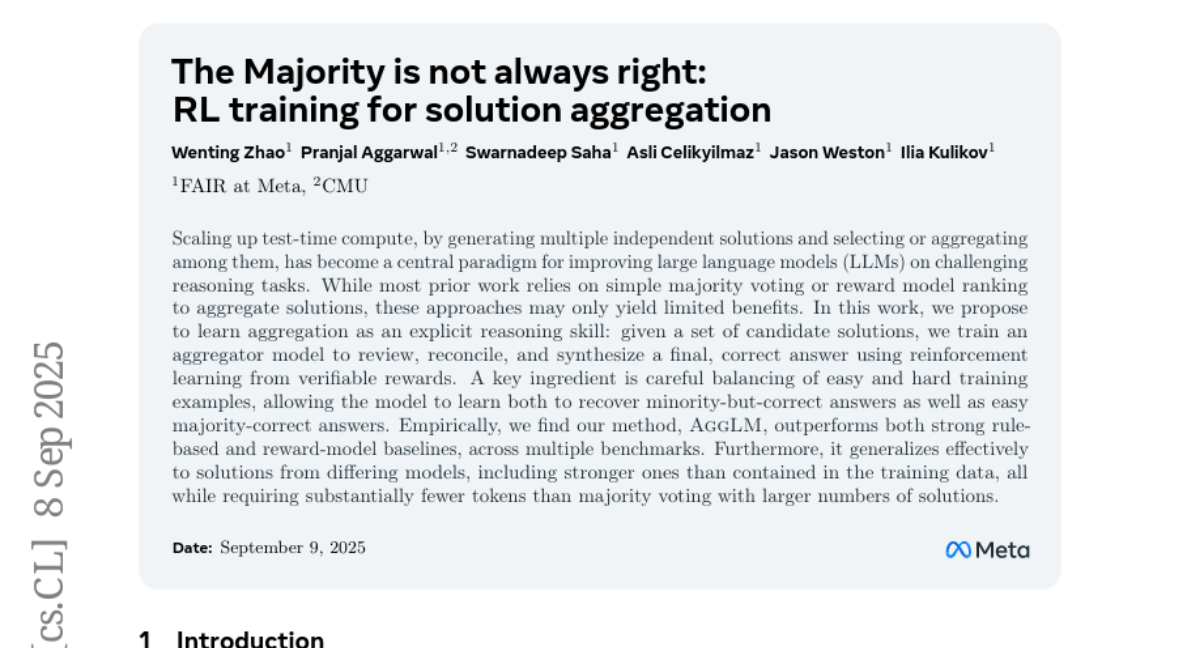
8. So let’s replace this phrase with insult… Lessons learned from generation of toxic texts with LLMs
🔑 Keywords: Large Language Models (LLMs), Detoxification, Lexical Diversity Gap, Synthetic Data
💡 Category: Natural Language Processing
🌟 Research Objective:
– To explore the use of LLM-generated synthetic toxic data as an alternative to human-generated data for training detoxification models.
🛠️ Research Methods:
– Synthetic toxic counterparts for neutral texts were generated using Llama 3 and Qwen models, drawing from ParaDetox and SST-2 datasets.
💬 Research Conclusions:
– Models fine-tuned on synthetic data exhibited up to 30% lower performance compared to those trained on human data.
– The key limitation identified is a lexical diversity gap in LLM-generated content, highlighting the continued importance of utilizing diverse, human-annotated data for robust detoxification systems.
👉 Paper link: https://huggingface.co/papers/2509.08358
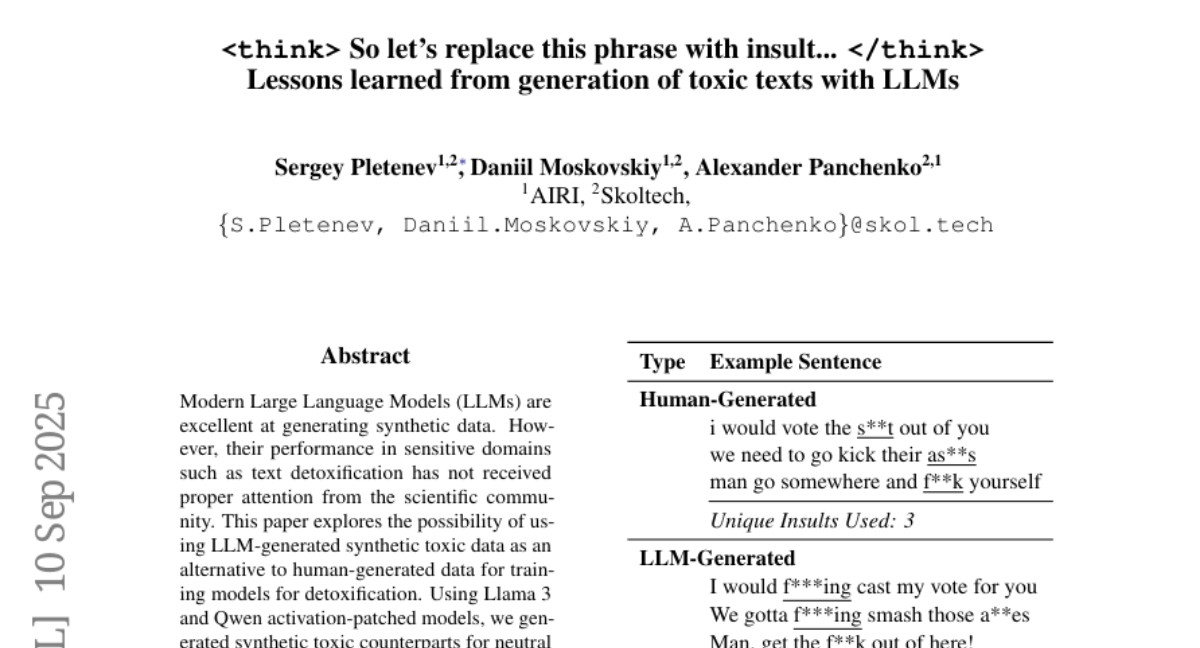
9. Statistical Methods in Generative AI
🔑 Keywords: Generative AI, Statistical Methods, Reliability, Quality, Efficiency
💡 Category: Generative Models
🌟 Research Objective:
– To review statistical methods that improve the reliability, quality, and efficiency of Generative AI techniques.
🛠️ Research Methods:
– Analyzing existing work on statistical techniques applied to Generative AI, discussing their applications, limitations, and potential future directions.
💬 Research Conclusions:
– Statistical methods can enhance the reliability, quality, and efficiency of Generative AI, though challenges in correctness, safety, and fairness remain.
👉 Paper link: https://huggingface.co/papers/2509.07054
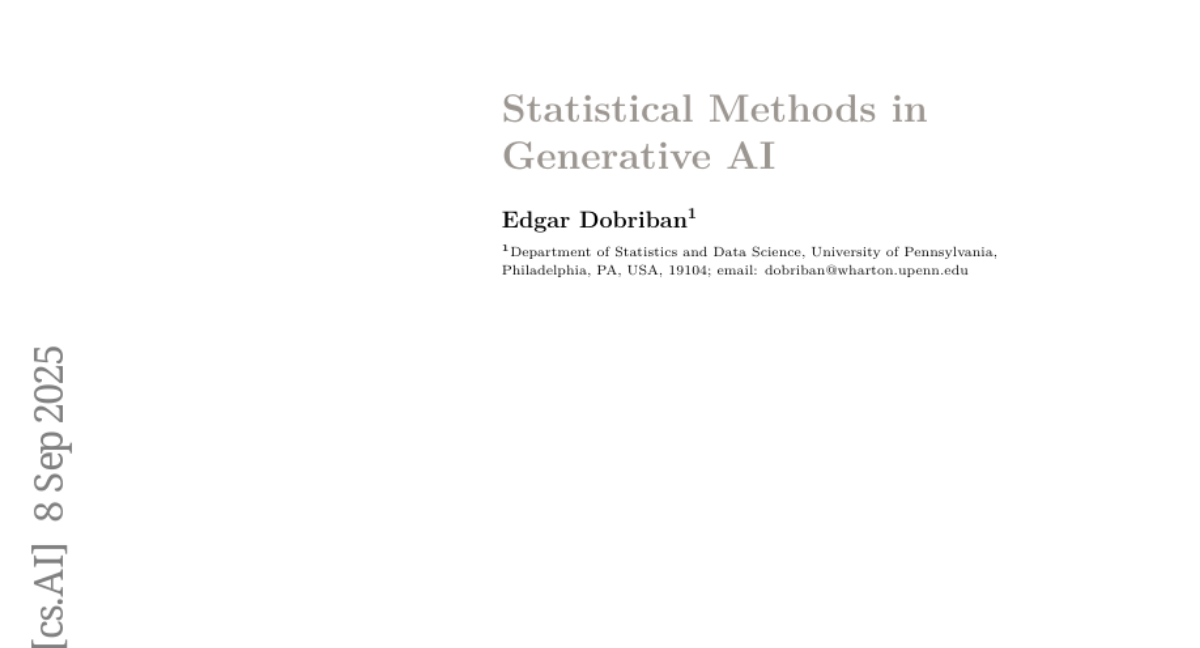
10. EnvX: Agentize Everything with Agentic AI
🔑 Keywords: Agentic AI, natural language interaction, inter-agent collaboration, structured tool integration, AI Native
💡 Category: AI Systems and Tools
🌟 Research Objective:
– The objective of the study is to leverage Agentic AI to transform GitHub repositories into intelligent agents, facilitating natural language interaction and collaboration, thereby automating the process of understanding, initializing, and operationalizing repository functionality.
🛠️ Research Methods:
– EnvX operates through a three-phase process: TODO-guided environment initialization to set up necessary dependencies, human-aligned agentic automation for autonomous task execution, and an Agent-to-Agent protocol to enable collaboration between multiple agents.
– The framework combines large language model capabilities with structured tool integration, enhancing automation capabilities beyond just code generation.
💬 Research Conclusions:
– EnvX demonstrates significant improvement in task execution, achieving a 74.07% execution completion rate and a 51.85% task pass rate on the GitTaskBench benchmark, outperforming existing frameworks.
– Case studies reveal EnvX’s potential in enabling multi-repository collaboration, marking a transition from passive code resources to interactive agents, enhancing accessibility and collaborative potential within the open-source ecosystem.
👉 Paper link: https://huggingface.co/papers/2509.08088
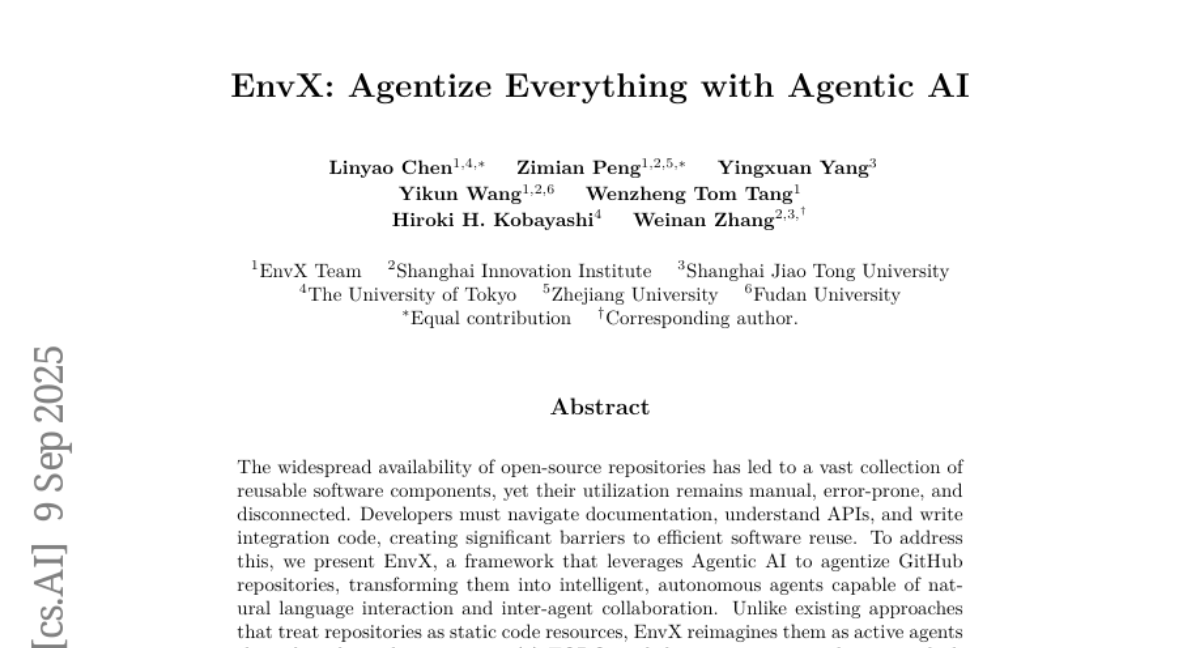
11. HumanAgencyBench: Scalable Evaluation of Human Agency Support in AI Assistants
🔑 Keywords: Human Agency, AI Assistants, Large Language Models, HumanAgencyBench, AI Ethics and Fairness
💡 Category: Human-AI Interaction
🌟 Research Objective:
– The study aims to evaluate human agency in AI assistants by integrating philosophical and scientific theories with AI-assisted evaluation methods.
🛠️ Research Methods:
– Development of HumanAgencyBench (HAB), a scalable benchmark with six dimensions, using large language models to simulate and validate user queries and evaluate AI responses.
💬 Research Conclusions:
– Contemporary LLM-based assistants exhibit low-to-moderate support for human agency with variations across developers and dimensions. Anthropic LLMs support human agency most overall but perform poorly in avoiding value manipulation. Increasing LLM capabilities does not consistently enhance agency support, prompting a call for improved safety and alignment targets.
👉 Paper link: https://huggingface.co/papers/2509.08494
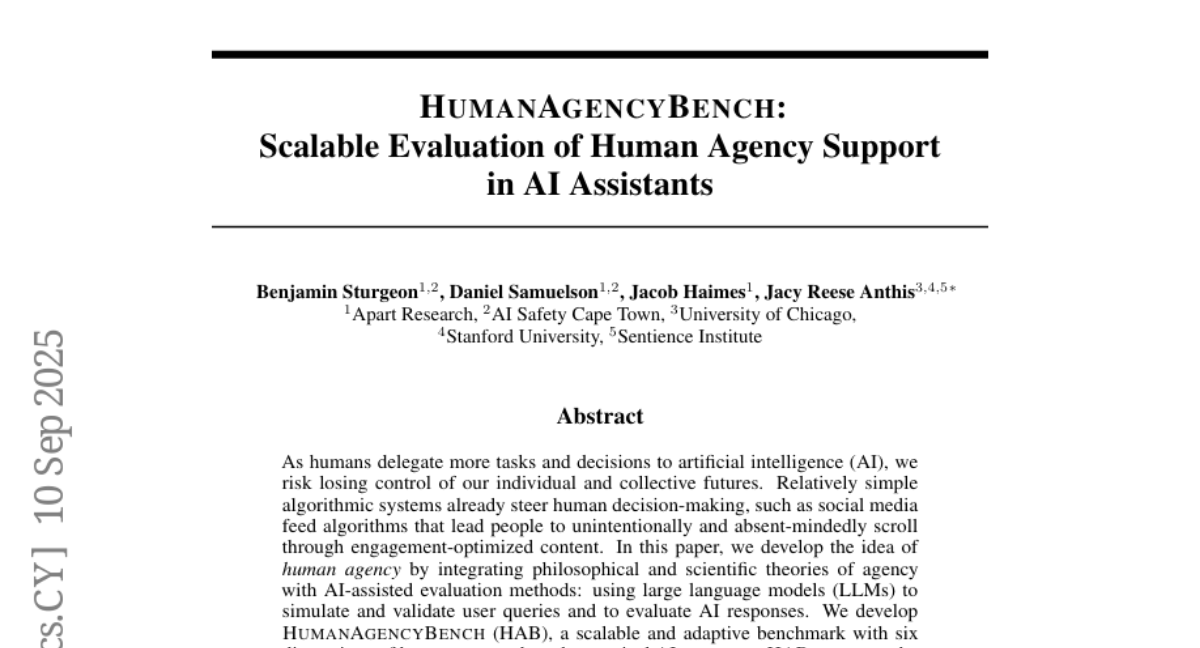
12.
